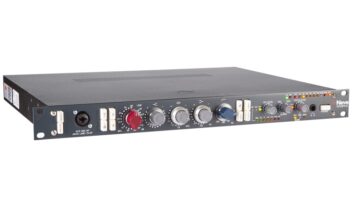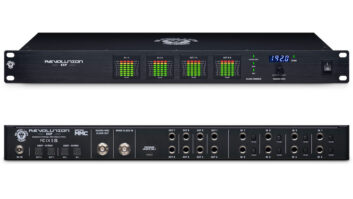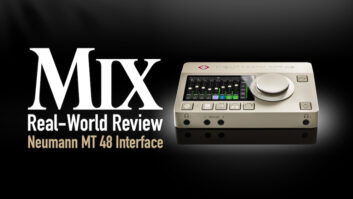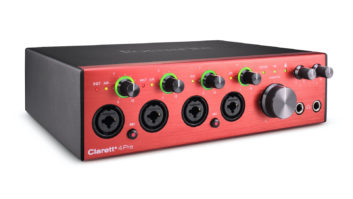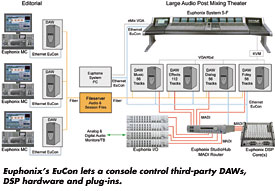
As mixers, our dream is an all-in-one system that allows complete
bi-directional control of workstation and console functions in real
time. And we know mixing console functions can be achieved within a
workstation, but most workstations lack an assignable control surface
for mixing. It’s not surprising when you remember that workstations and
mixers do not share a common heredity. Digital audio workstations
(DAWs) evolved from tape- and then disk-based recorders, while mixers
have grown in complexity and operational depth as audio production
became increasingly complex. And because the underlying technologies
are radically different, it’s no surprise that there are few, if any,
manufacturers offering both types of products.
However, there are several ways in which a DAW’s Mix Engine can be
controlled while adjusting channel levels, routing, pan, EQ, dynamics
and other parameters. The easiest way is to route playback outputs at a
fixed level to an external analog/digital mixer and then control the
parameters there. Problem: We now have two sets of functions to deal
with: the workstation’s track assignments, built-in static processing
and plug-in values, plus the conventional mix/EQ/dynamics automation
data from the console.
The second technique might be to develop a MIDI-based external
controller that issues commands to the workstation via standardized
commands running at MIDI’s relatively slow data rate. But we still need
to deal with the MIDI commands and the DAW settings for full recall and
reset. A good example of this approach is Yamaha’s DM2000 Assignable
Digital Console. As Marc Lopez, DM2000 product manager, explains,
“With the strong trend in using a DAW for recording and mixing,
most engineers feel they still need tactile control to improve the
computer-centric workflow of a DAW. The DM2000 integrates tightly with
[DAWs] to create a complete production and mixing environment.”
External DAW control is via multiport USB I/O, using a single MIDI port
per bank of eight channel faders. (Yamaha’s 02R96, DM1000 and 01V96
also support these protocols.)
“Extensive support for Digidesign’s Pro Tools provides full
control of mixing and processing, as well as transport/track-arming
control and access to editing functions directly from the
DM2000,” Lopez continues. “Advanced support for Steinberg’s
Nuendo DAW is also under development.” The Nuendo Virtual Channel
Strip, available in the DM2000 Version 2 software’s Advanced DAW
Support feature, enables users to control Nuendo and Cubase EQ, stereo
and surround panning, and aux sends from the DM2000’s Virtual Channel
strip. These are controllable functions that vary depending on the DAW
software being used. Version 2 also offers surround panner control for
Pro Tools.
And let’s not overlook Loud Technologies, whose Mackie Control, HUI
and Baby HUI systems provide MIDI-based control of a number of popular
DAWs, including MOTU Digital Performer, Steinberg Nuendo and Cubase,
Soundscape (via Mixpander), Digidesign Pro Tools and PT LE, Cakewalk
Sonar, Emagic Logic, Magix Samplitude and Sequoia 7, Adobe Audition and
RML Labs SAWStudio. (The firm’s dXb and older d8b Digital Production
Consoles also feature Control and HUI modes to control Pro Tools, Logic
and many other DAWs.)
The new Tascam US-2400 Control Surface is also pre-mapped for any
DAW software that supports HUI or Mackie Control protocols. The unit
features 24 touch-sensitive moving faders, rotary encoders with LEDs
(remappable as 4-band EQ sections, for example) and a joystick
controller. Bank switching enables access to 192 DAW channels. A
transport section features a jog/shuttle wheel.
DAW COMMAND

The third scenario would be to develop a dedicated set of commands
that a DAW could recognize; arrange for them to be sent at a
sufficiently rapid rate so that we can develop medium- and large-format
console topologies; and store all of the frame-accurate settings within
the DAW. Instant recall of every parameter is now possible, along with
the availability of familiar designs of control surfaces. A number of
manufacturers, including Euphonix and Fairlight, are developing such
capabilities and their motivation is pretty obvious: Euphonix, like
other makers of large-format digital consoles, has obviously seen the
writing on the wall — Big is Expensive. A great deal more
functionality is now available from DAWs based on commodity processors,
and the only serious drawback has been how to control all of this
power.
Euphonix’s EuCon object-oriented Command Protocol allows a mixing
console to control third-party DAWs, special-purpose DSP hardware and
software plug-ins. “Existing command-based interfaces were not up
to the task,” says Martin Kloiber, Euphonix executive VP of
technology, “because they were either too rigidly limited in
their format or put too much programming burden on the developer, or
both.
“An object-oriented interface is a good choice because mixing
consoles and audio processors fit neatly into the object
paradigm,” Kloiber continues. “Channels, buses, faders,
knobs, meters and such are all easily comprehended as discrete objects.
Also, consoles typically have a hierarchical design that lends itself
well to object modeling. For example, a console includes many
replicated channels, each channel including a fader that has a level
control slider, mute switch and so on.”
EuCon is currently being used to control the Euphonix System 5 DSP
Engine from the S5’s (and post/broadcast variants) assignable control
surfaces and within the new MC Intelligent Application Controller.
“The [EuCon] architecture will allow several DAWs to be
controlled from a System 5 for film-dubbing applications,” offers
Kloiber. “The operator will be able to bring each individual
track from any of the DAWs up on the System 5 control surface, as well
as handle all audio patching between systems.” In addition to
conventional fader, knob and switch commands, EuCon includes
instructions for DAW plug-ins and other functions relevant to edit
functions. A prototype of the MC Controller was shown at the New York
AES Convention last fall; production versions are expected to be
unveiled at the upcoming San Francisco Convention in October.
“The MC is a DSP-less console,” Kloiber emphasizes.
“All of the control takes place inside the workstation. EuCon can
also act as a hub to translate different protocols between different
systems.”
Euphonix is closely working with Steinberg and other DAW
manufacturers to enable full MC control. At recent trade shows,
Euphonix demonstrated work-in-progress with Nuendo and is in discussion
with other DAW makers. “Our philosophy is to enable users to
utilize the best class of products in an integrated environment,”
Kloiber stresses. “EuCon is ‘DAW-agnostic’.” MC
provides high-speed control of not only EuCon-aware applications, such
as Nuendo, but also any PC application via keystroke commands. The unit
includes a 5.1 monitor section, twin trackballs, a QWERTY keyboard,
eight programmable knobs, four moving faders and 56 programmable LCD
SmartSwitches.
“In March [2004], we released an SDK [Software Developers
Toolkit, a set of utilities that allows programmers to include
high-level routines into existing software applications],”
Kloiber concludes. “The SDK will reduce the time it takes for a
DAW maker to add EuCon command to six to eight weeks using the MC
Controller’s physical controls. Programmers can use command sets
already available [within the SDK] and translate them to the specific
DAW.”
With a foot in both the digital control console and DAW camps,
Fairlight has an inside track on connectivity, at least between its own
products. Unveiled at last fall’s AES Convention, the Dream
Constellation large-format digital console now offers control of
external workstations via the firm’s RAPID Protocol Sharing Initiative.
Dream Constellation is powered by Fairlight’s QDC engine and a Binnacle
control surface that supports up to 144 channels, 48 buses and 32 mono
multitrack buses. According to Fairlight CEO John Lancken, “RAPID
— Remote Application Program Interface for Dream — was
developed [as] an open operating platform that enables automation, disk
recording, editing, plug-ins, SFX, video and all other elements to be
stored and controlled from a single control surface.” Because
RAPID is already implemented across the Dream product range, external
PCs can be used as clients with Fairlight products. Video editing
functions are also included.
Like EuCon, RAPID SDKs are now available from Fairlight.
“Being a small API, compared to something like Windows, [RAPID]
is generic and easy to implement,” Lancken adds. “The SDK
contains a document, sample code and information on how to use the
API.” Fairlight has also set up a Website that supports three
levels of implementation: bronze, silver and gold. “Bronze-level
implementation covers transport only,” Lancken says, “while
silver handles transport and mix functions, including dynamics. Gold
includes the silver-level functionality, plus editing and automation.
The forthcoming platinum level will handle all of that, plus plug-ins
and video.”
LARGE-FORMAT DIGITAL CONSOLES
Unlike EuCon, RAPID isn’t a control protocol. Instead, a dedicated
PC gathers all of the various data that comprises a complete music or
post project and allows the stored data to reproduce the same
time-dependent environment. “This data will be DAW-specific, but
once the software is implemented, a ‘sniffer’ program
detects the nature of data being passed backward and forward and stores
changes,” Lancken continues. “Upon playback, RAPID simply
re-creates the changes it detected during the original session.”
In this sense, RAPID is more like AAF than EuCon, for example, in that
it monitors real-time changes in a project rather that the commands it
follows on a communications channel.
Across the Atlantic, a duo of UK-based console manufacturers has
also given serious thought to workstation control from a central mix
location. As Niall Feldman, Solid State Logic’s director of product
management, offers, “SSL has some history with developing
integrated workstations and mixing consoles; products such as Scenaria
and Omnimix pioneered this ‘third generation’ more than 10
years ago. Our experience in that development path was that one editing
solution didn’t fit all applications, and editing methods and platforms
were a significant product development challenge in themselves.
“In both our XL 9000 and C200 consoles,” Feldman
continues, “there is control integration for DAW systems. In the
C200, there is also the ability to control DAW processing/parameters
from a central, assignable plasma display.” A large-format
digital console, Feldman reasons, “has more processing horsepower
and can therefore process more complex algorithms on many channels
simultaneously. The processing and performance aren’t being compromised
by the scale of what you’re trying to do, which is sometimes the case
in a complex DAW mix.”
SSL currently supports MIDI, USB and RS422 serial data. “Our
systems support other protocols such as Ethernet,” Feldman adds,
“and therefore, we have several development options. We try to
use standardized protocols wherever possible, as this provides the
greatest flexibility. At a professional level, Pro Tools is the
predominant DAW we encounter, though we have many consoles that have
integrated Fairlight control. Emagic Logic is also popular.”
As Mike Reddick, AMS Neve’s editorial products manager, points out,
“From the early ’90s, [we] recognized the importance of
editor/mix integration. This was the thinking behind the Logic 1, the
world’s first integrated editorial workstation. Even back then, [the
system featured an] integrated project format allowing audio, EDL,
console configuration and automation to be stored together in one
place.”
THE OTHER END OF THE TELESCOPE: DAW MANUFACTURERS
At the NAB 2004 Convention, AMS Neve was scheduled to unveil the
latest element in its integrated solution. Workflow is the firm’s
approach to post work as it flows through a facility via a StarNet
network. “To this end,” Reddick says, “the solution
integrates editorial, mixing, DSP processes [plug-ins], control by and
of third-party systems [via TCP/IP], networking, secure storage and
nonlinear picture playback.” Workflow and StarNet enable virtual
object — oriented mixing, “allowing any element of the
project to be changed at any stage, and for these changes to be visible
and accessible at any other,” Reddick concludes.
If digital console manufacturers are actively pursing the potential
of controlling external workstations, then what of the DAW makers? For
example, Steinberg continues to work with Euphonix to refine EuCon
functionality. But, according to Martin Stahl, Steinberg’s project
coordinator for post-production, the firm offers MIDI- and USB-based
external control of Nuendo from such devices as Yamaha DM2000 and 02R96
consoles, and has just released its own dedicated control surface.
Developed with German company WK Audio, the USB-based ID Controller
enables real-time control of more than 128 Nuendo playback channels.
(The target is 340 channels, according to Stahl.) The ID control
surface features 12 assignable faders and rotary controls, plus a
separate editor section with jog wheel.
In terms of EuCon-based controllers, Steinberg senior product
manager for pro audio, Lars Baumann, explains that Nuendo has basic
connectivity available now, but that a public release is not planned
before more functions are added. “Upcoming versions of Nuendo
will offer a new feature set that we will open for control using our
own protocol — and be compatible with EuCon — but will
allow us to control our own destiny,” he says. Currently under
final development is a Hardware Controller SDK that will allow
third-party vendors to develop suitable solutions. “We decided to
develop our own protocol, as well as continuing to support EuCon and
MIDI, simply because we don’t want to [favor one manufacturer over
another],” says Baumann. “We are currently adapting to many
brands of hardware controllers, [but] would like to redirect this
effort to the manufacturers and keep our focus on the software. With
the SDK, we can develop a means of Nuendo control via Ethernet,
FireWire, USB or any other I/O that maximizes Nuendo’s
user-friendliness.”
SADiE has experience in DAW/console integration, having co-developed
a system four years ago with Soundtracs. But the experience was not too
thrilling, as managing director Joe Bull confesses. “Part of us
won’t go there again,” he recalls. “Innovation can be
[troublesome], because it is often difficult to get a mixer
manufacturer to completely comprehend the intricacies of DAW
technology. We had a great solution that responded very well, but then
Soundtracs went off on its own.”
Bull is quick to point out that current-generation DAWs offer
powerful mixing functionality: “It’s a matter of developing a
means of controlling those capabilities,” he rationalizes.
“Mixing is a more linear function, and it takes focused design to
appreciate the differences. Our R&D department is currently asking
a number of pertinent questions, including ‘What do users want
the system to do?’ ‘What protocols are available?’ We
have looked at EuCon, but if we go down that route, what about rival
manufacturers like SSL and AMS Neve? Are we painting ourselves into a
corner?
“We have looked at integrating SADiE’s workstations with
large-scale consoles,” Bull concedes, “but most customers
want a choice of control surface for their chosen DAW. If we lock into
one solution, we may compromise some features. And there may be
situations where we sell a DAW system to a facility that is more
familiar with a mixer that we don’t support. Personally, I’d like to
see the AES [organization] develop a standardized protocol between DAWs
and assignable control surfaces.
“In reality, for smaller installations, we currently support
MIDI control from Yamaha’s DM2000 console or [Mackie] HUI Series. But
what do customers need [in terms of mixing functions]? An SSL? A
Euphonix? Or maybe the [Sony] DMX-R100 or DM2000 [medium-format]
console might represent a larger market? What does the
‘average’ facility or studio want? That is the
crucial part of the equation. Is the market too small for
bipartisan development? And music, broadcast and post are looking for
different solutions.”
Merging Technologies’ sales and marketing manager Ken Barnsley also
stresses the importance in considering current-generation DAWs as
combination editor/mixers and not just editing stations. “Pyramix
with Version 5.0 software has a 128-channel digital console with
assignable buses, I/O aux sends, et cetera — a real live
mixing desk, it just doesn’t have any metal in front of it,” he
says. “We already support MIDI, UI and Yamaha protocols, but
believe we must take this much further to a multifaceted and
multilayered control, protocol-specific Pyramix.”
The firm is currently developing an advanced protocol that will
allow a digital console to control Pyramix and create additional layers
of mix capability even to smaller digital console configurations.
Barnsley foresees initial applications within film dubbing and is in
active discussion with three major console manufacturers specifically
for this application. Recently, Merging Technologies issued an SDK to
the initial console makers involved in the project.
Pyramix can internally mix up to 128 channels and offers up to 128
outputs. “These can be configured as individual internal mix
layers with discrete outputs to create single or multiple premix output
layers,” Barnsley says. “In effect, Pyramix can supply any
number of discrete premix outputs from the same system or even multiple
systems, which is usually the case. If the console has control over
Pyramix’s virtual mixer, I/O routing, processing functions and each mix
layer, the premix process can be achieved from the console but without
the need to destructively mix down.”
The leading DAW manufacturer — in terms of installed systems
— is Digidesign, which has developed a number of proprietary
control surfaces for its Pro Tools Series, ranging from the entry-level
LE Music Production System through Pro Control and Control|24 to the
new D-Control Audio Worksurface. [See “Technology
Spotlight,” Mix, April 2004] “Control surface
solutions complement rather than replace the Pro Tools software
interface,” says David Gibbons, Digidesign’s marketing
manager.
Stan Cotey, Digidesign’s senior product manager for hardware, offers
that over time, workstations’ internal mixing capability has become an
important addition. “Often, the amount of power available for
mixing was in contention with the editing features, graphical user
interface updates, OS overhead, et cetera,” he says.
“Digidesign’s offering during this time used the same host
computer for editing and automation, while offloading all of the
intensive audio processing to a built-in, high-quality DSP hardware
accelerator system. This allowed integration between audio and
automation data, and the ability to save one session file that
contained all of the automation data, audio edits, routing, system
settings, et cetera.”
Perhaps an intermediate generation can be thought of as involving
data interchange between systems, Cotey considers, “allowing
automation data from a console to be affected by the editing done on a
DAW [and] also network interchange between two different DAWs. This led
to the emergence of widely adopted interchange standards for groups of
related files — like OMF and AAF — but didn’t lead to a
real-time control parameter standard other than MIDI.” Cotey
allows that new standards may emerge over time, possibly including
EuCon.
“In most cases,” Cotey concludes, “supporting
these interactions comes at a great cost to the alternative feature
development we would like to do within Pro Tools. When we choose not to
support something, it’s usually because the burden of maintaining the
support is too great, considering the demands we are trying to meet
from users for other features. It’s sensible for us to wait to see if a
new standard will be widely adopted before moving to support
it.”
Of course, Digidesign’s new ICON eliminates the need for a separate
analog or digital console because every Pro Tools function —
including plug-ins — can be mapped to faders, knobs or switches
on the control surface via a high-speed Ethernet connection to the host
Mix Engine. But there are no plans to make the connection protocol
available to third-party developers. “Our protocol remains
proprietary,” Gibbons stresses. “It is simply a matter of
available resources. Currently, we have a team of four in-house
developers that support our plug-in program. If we tried to create and
publish a control surface protocol, we would need an even larger team
to provide technical support to OEMs. While we understand the market’s
needs, the amount of resources we’d need to provide would not be
viable.”
MIDI still provides an easy-to-implement control of Pro Tools
functions from an external console or control surface, says Gibbons.
“[MIDI] might not be the best solution [in terms of speed and
depth of control functions], but it gets the job done. And it’s an open
standard that everybody understands!”
All of which makes sense. Digidesign is both burdened and blessed
with its acknowledged success. A large installed user base means that
control surface developers, including makers of large-format consoles,
are eager to tap into an existing market. However, for Digidesign to
spend the time and dollars to innovate or accommodate a new protocol
that provides access to every element of its powerful mixing and
processing engine makes miserable commercial sense. Great to play
nice-guy, but are there better ways to make friends and influence their
key customers? Yes, indeed.
Digidesign is not inattentive to the control surface paradigm
— witness the new ICON and ongoing success of ProControl and
Control|24. While ProControl and Control|24 may arguably lack all of
the bells and whistles of offerings from SSL, AMS Neve or Euphonix,
many music and post users are using them day to day. And several
console manufacturers are actively considering protocol schemes like
EuCon and RAPID, which can add a level of connectivity and system
integration that is needed by the growing breed of audio engineers for
whom the distinction between editing and mixing seems arcane and
unacceptable.
A major unknown on the immediate landscape remains Apple Computer, a
company that certainly possesses the resources to develop a fully
integrated solution and one that will find immediate appeal to the
project studio, sound editorial and musician user. Logic is a popular
production tool and could benefit from an Apple-developed control
interface. It remains to be seen whether Apple will consider this a
viable proposition — and with sufficient ROI.
One thing is certain: While Apple remains pre-eminent at dominating
its target markets, and is winning hearts and minds in the Windows
community, Digidesign’s business model is now based on a closed
architecture that requires customers to purchase proprietary Digidesign
hardware to run the firm’s software. In contrast, Apple is offering
standard software with an open plug-in architecture and an open
hardware interface, a paradigm also supported by Steinberg and other
DAW makers. All of which opens the door for other companies to develop
solutions — including full-capability console control surfaces
— that plug into the Apple-innovated hardware and operate within
an Apple software architecture. Truly, we live in interesting
times.
Mel Lambert heads up Media&Marketing (www.mediaandmarketing.com), a full-service
consulting service for pro audio firms and facilities.

